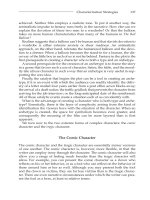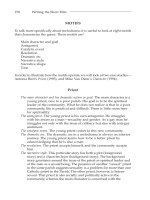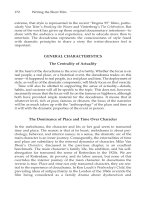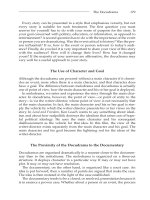Tài liệu Writing the short film 3th - Part 26 ppt
Bạn đang xem bản rút gọn của tài liệu. Xem và tải ngay bản đầy đủ của tài liệu tại đây (120.44 KB, 7 trang )
to a resolution and generally implies a diminished role for characterization.
In short, if you use plot, the likelihood is that it will play a dominant role in
the script. There are short films, such as The Lady in Waiting (see Appendix B),
where a very modest plot is used; the New York blackout is more a plot
device than plot proper, but it is nevertheless the plot of The Lady in Waiting.
More often, however, when a plot is used it dominates the short script.
Because it does so, it bears down on the main character and his or her goal
with particular intensity. If that plot does not oppose the main character’s
goal, the script as a whole softens under the intensity of a character’s pur-
suit, with too little resistance offered to that pursuit. The result is a loss of
credibility in the character. This is true for melodrama.
It’s useful to look for a moment at the situation comedy, which is the “pos-
itive” (in photographic terms) of the melodrama. This means that elements
such as plot will be used in the opposite way to how they’re used in the
melodrama. In Matthew Huffman’s film Secret Santa, it is Christmas time.
The seven-year-old main character simply wants not to be bullied and belit-
tled by a larger classmate. That’s his goal. The plot enables him to achieve
that goal as follows: A bank robbery is carried out by six men wearing Santa
Claus outfits. One escapes, but is injured in his hurry to get away. He is
found by the seven-year-old, who believes he has found Santa Claus. He
takes him home, where the robber hides in the basement. This is the catalytic
event. In the second act, the boy befriends “Santa” and convinces him to
have words with the bully. “Santa” tells the bully to be good—or no presents
this year. The bully complies: the main character achieves his goal. (“Santa”
is caught climbing out of the basement window.). Here the plot—robbery
and its aftermath—enables the main character to achieve his goal.
Tone
Generally, the tone of the long-form melodrama is realistic. The short film
has a much greater tolerance for moving away from realism. Because of the
urgency of the character and his goal, or conversely, because of the intensity
of the plot, subjectivity and irony both have a place in the melodrama. In this
sense, the short film more readily offers the writer the option to enlist his or
her voice directly in the script.
CASE STUDIES
These case studies will illustrate how short films that are melodramas use
character, structure, and tone.
The Melodrama 165
Ch13.qxd 9/27/04 6:10 PM Page 165
Case Studies in Character
In Elke Rosthal’s My Name Is Rabbit, a young woman returns to visit the father
she has not seen since she was a child. As a child, she had been a witness to her
mother’s death in a car accident; her father had been driving. The current visit
does not go well. Her father, an alcoholic, is inappropriately affectionate with
her. He’s sexually jealous of a friend she has made at work. In fact, the visit is a
disaster, but it does prompt her to recall her early life. She remembers his tem-
per and his possessiveness toward her mother. As the story ends, she is left with
a conscious feeling of her guilt for her mother’s death. She felt guilty because the
accident occurred when her father swerved to avoid hitting a rabbit. He had
always called her Rabbit.
In My Name Is Rabbit, the character pursues her goal of a relationship with
a father who is a mystery to her. Although she discovers that a relationship
is impossible, her pursuit is understandable and earnest. Because she is
modest, her father’s over-the-top drinking and salaciousness is all the more
shocking. By the end of the film, we understand that it is the father, rather
than Rabbit, who bears the responsibility for the family tragedy.
Case Studies in Structure
Christian Taylor’s The Lady in Waiting (see Appendix B) proceeds in an Act
I–Act II structure, essentially resulting in an open-ended conclusion.
In this film, the main character is asked to take a letter to New York. This
event—taking the letter to New York—is not the same as the catalytic event,
or turning point between acts. The turning point here is when the elevator
stops as a result of the power outage. Act II is dominated by the exploration
of the relationship between Miss Peach and Scarlett. From the elevator, to the
apartment, to the parting of their ways, the focus is on how Scarlett influ-
ences Miss Peach. The story is character-driven; it has little plot (the power
outage). The end is open, leaving us hopeful that Miss Peach will feel better
about herself. She remains, however, marginalized.
Graham Justice’s A Children’s Story exemplifies the Act I–Act III structure.
The main character is a six-year-old girl. The film opens with children being
very playful on a school bus. The driver tells them to settle down, not to
show each other their underwear. The driver seems to be a genuine friend to
the main character. In the following scene, a school psychologist looks into a
parallel incident, where the driver was inappropriately friendly with the
children. The act ends with the driver being arrested for molesting the main
character. In the next act, the investigation continues. We learn that the main
character has had “numerous fathers.” The community is pressing for con-
viction of the driver. This requires the testimony of the main character. As the
166 Writing the Short Film
Ch13.qxd 9/27/04 6:10 PM Page 166
psychologist tries to learn more via play therapy, the main character is fear-
ful about releasing a secret. Ultimately, though, she inadvertently reveals
that it is the mother’s current lover who has been molesting her. The script
ends with the driver freed, once again presented as a true and caring friend
to the main character.
In A Children’s Story, the discovery of the true antagonist and his conse-
quent arrest brings the story to resolution. In this sense, the long act resem-
bles Act III of a feature film.
A Case Study in Plot
Graham Justice’s A Children’s Story also provides us with an example of the
deployment of plot in the short film. In the classic sense of melodrama, plot
works in opposition to the main character’s goal. In this film, the goal of the
main character is to keep the family secret of sexual abuse. She does so out
of fear of losing her mother’s love. The plot—the investigation into the case
of sexual abuse—puts continual pressure (via the school psychologist) on the
main character. As the investigation progresses, so does the pressure to
reveal the secret.
As expected in a melodrama with plot, there will be resolution and,
accordingly, an Act I–Act III structure. There also will be twists and turns—
thus the catalytic event, the arrest of the driver; and the resolution, the arrest
of the mother’s lover. What also needs to be mentioned is that the presence
of plot diminishes the level of characterization in the screenplay as well as
the screenplay’s dependence on the dialogue for energy. In plot-driven melo-
dramas, the characterizations are often stereotypes, and the energy in the
screenplay derives instead from the twists and turns of plot.
Case Studies in Tone
The tone of the short melodrama is usually realistic. Christian Taylor’s The
Lady in Waiting and Graham Justice’s A Children’s Story are each presented
realistically. This means recognizable characters in recognizable situations.
The result is a dramatic arc for the main character that does not veer from the
expected.
Having confirmed the expected tone of the genre, it’s important to reaf-
firm that tone in the short film has a wider latitude than does tone in the
long-form melodrama. Two examples will illustrate the point. Ayanna
Elliot’s Tough is a story of a teenager. The story is simple, “a day in the life.”
But it’s a special day—the first day she menstruates. She is on the verge of
womanhood. Also, her father (divorced from her mother) is to take her out
The Melodrama 167
Ch13.qxd 9/27/04 6:10 PM Page 167
for the day. The incidents in the story are as follows: She has a vicious argu-
ment with her mother. Her mother is more attentive to her female lover than
she is to her daughter’s anxiety about menstruation. The main character
decides to move out. Her father does not realize it, but the main character is
now planning to be with him for more than the day. The main character
insists on bringing a friend along. The father insists on bringing his new
lover along. Needless to say, parenting is not the order of the day—rather,
who can be more childish, the adults or the children, is the goal.
In order to make her point about “who is the parent here,” Ayanna Elliot
uses humor and irony. If there is a consistent tone to Tough, it is irony. The
tone is effective in making her point about parenting.
Emily Weissman’s Pocketful of Stones offers a very different tone. This film
opens with the admission of the main character, in her late teens, into a hos-
pital. She has attempted suicide; a failed relationship has driven her to the
act. The story focuses on her hospital stay. Will she get better or worse? The
story ends with her more withdrawn than ever and confined to the hospital.
In between, we learn that her goal is to get out of the hospital. Although
rebellious toward authority (the nurse), she is nevertheless fairly reality
based. She develops a relationship with a young man, also a patient.
Through his influence and control, she is coaxed into self-mutilating behav-
ior, and she becomes increasingly withdrawn, then aggressive. She goes
from talking with the psychiatrist about a release plan, to behavior troubling
enough to preclude release. At the end of the story, she is worse off than she
had been at the beginning.
The tone in Pocketful of Stones is expressionistic, even nightmarish, empha-
sizing the main character’s emotional, subjective state. By doing so, Emily
Weissman puts us in her place—time is obliterated, authority figures are
monsters, the hospital is a war zone. By resorting to an exceedingly subjec-
tive tone, Emily Weissman avoids the case-study approach and takes us
inside mental illness. The result is very powerful. Here again, moving away
from the expected tone creates a powerful and fresh experience. Here tone
makes the short film quite an original experience.
Summation
The key issue in writing melodrama in the short film is that there are classic
commonalties between the long and short forms—the nature of the main
character’s struggle, his or her powerless against the power structure, the
recognizability of character and situation, the characters living the lives that
we do, and of course the narrative approach, which is essentially realist.
But the differences between long and short films are considerable.
Compression of time means faster characterization and fewer characters and
168 Writing the Short Film
Ch13.qxd 9/27/04 6:10 PM Page 168
plot. It also means a structural choice—for an Act I–II approach or an Act
I–III approach. The short film also allows the writer latitude in the area of
tone. Like the short story, metaphor and poetics can work in the short melo-
drama in a way that the need for greater characterization and plot tends to
disallow in the long film. The key in all your considerations about the short
film is to be aware of these similarities and differences.
The Melodrama 169
Ch13.qxd 9/27/04 6:10 PM Page 169









